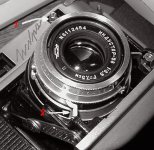minoltist7
pussy photographer
http://www.flickr.com/photos/22919025@N05/tags/iskra/
and sort of problem, as seen here:
http://www.flickr.com/photos/22919025@N05/2503446298/sizes/o/
thin, long horizontal dark lines (scratches?) on film.
It's seen only on bw film Fomapan 200, developed by myself.
If camera scratches the film, where can it happen?
Pressure plate does not touch the film, as it's covered by backing paper
and sort of problem, as seen here:
http://www.flickr.com/photos/22919025@N05/2503446298/sizes/o/
thin, long horizontal dark lines (scratches?) on film.
It's seen only on bw film Fomapan 200, developed by myself.
If camera scratches the film, where can it happen?
Pressure plate does not touch the film, as it's covered by backing paper


